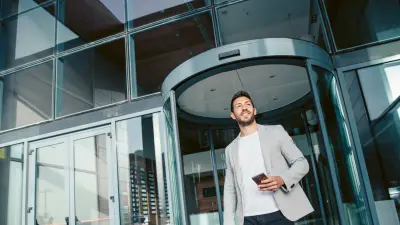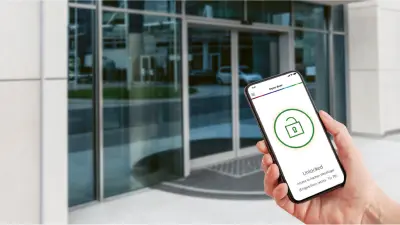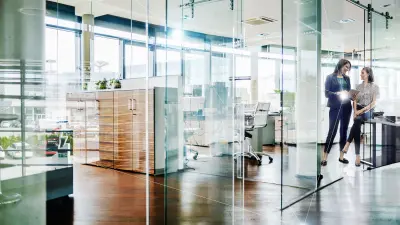Opening doors with a smartphone
An innovation team is working hard on a mobile access solution for new office environments and smart neighborhoods.

When Julia Steinacker rides her bike to work at Bosch in Aachen every morning, she no longer has to stop, rummage around in her bag to fish out her card and hold it in front of a card reader. The garage simply opens on its own. On the way into the building en route to her office, she simply holds her mobile phone in front of the card reader instead of a plastic card and the door opener reacts right away. All she has to have with her is her smartphone, which is something you don’t forget as readily as a card. The 33-year-old has been working with her team on the new solution, which enables this ‘open sesame’ access and other flexible options for access control with a smartphone, for just over a year.
Julia Steinacker studied industrial engineering in Aachen and has been at Bosch for four years. As a product manager, she has been working on the topic of cards and readers from the very start. In the process, she maintains a vigorous dialog with her customers, whose companies were often spread over several locations and who had to manage and request a corresponding number of different access cards. “Why can’t I use my smartphone to access the site?” was a question she began to hear more and more often. It quickly became clear: “This is turning into such a big trend that it could completely change the market for access systems.”

Unlike access cards, smartphones are always handy
As part of a Bosch innovation program, Julia Steinacker and her colleague Ulrich Pinsdorf (from Engineering) were given the opportunity to develop a mobile access solution with a team specifically put together for this purpose. The mission: to find the most straightforward, most flexible and most secure entry solution possible on a smartphone, capable of being integrated into existing or new access systems at the customer’s premises. Julia Steinacker: “It has to be easy to understand and data protection-compliant, it has to work reliably and it can’t be any more complicated than using an access card.”
And mobile access must be able to be granted to employees as well as visitors and be supported by the respective management system, such as Bosch visitor management. Until now, for example, visitors, external participants in a meeting or service providers had to hope that there was someone at reception who also had time for them, and that there was no long line of people waiting for access cards to be issued. It was all too easy to arrive too late. On part of the operator of the company building, this involved considerable outlay in terms of time, personnel and therefore also costs: the operator must ensure that reception is adequately and competently staffed, that there are enough easy-to-program plastic access cards available, and also ensure that the cards are handed over by visitors when they leave the building. In addition, cards like this are often misplaced or forgotten – this rarely happens with your smartphone.

New working worlds require new opportunities
The requirements for building operators are becoming even more complex as working environments change. If there are no fixed workstations, alternating teams only come together to work on a specific project and team rooms and other resources need to be used flexibly, meaning the mobile access solution offers many other advantages compared to the card. Two-way authentication on a smartphone, an app communicating with the reader using low-energy Bluetooth, and interfaces to existing management systems offer many more options for flexible configuration and deployment. Julia Steinacker was quite skeptical about the smartphone as a door opener when the development process began. This was due to a personal experience, when a booked holiday apartment could not be opened using her cell phone as had been promised. “It was really annoying!”. In the meantime, her own project has completely convinced her that the smartphone “has huge advantages and that it’s a cool solution”.
For Julia Steinacker and her team, intensive user research has been at the core of the development of the new system in recent months. What is important for visitor processes? What are the technical requirements? What security requirements and data protection requirements does the system have to meet? These were some of the questions that the team asked again and again over the course of many interviews and discussions in workshops. They then adapted the mobile access solution accordingly, had it trialed again by test customers, and scrutinized it again in more interviews until everyone involved was ultimately satisfied with it.
Guaranteed security thanks to two-factor authentication
As part of the user research, the team also held intense discussions with portfolio managers at real estate companies. A new trend in the industry is campus projects with different user groups, such as people renting apartments, employees in offices, and a public that uses all the other spaces – from retail stores to day care centers. Projects like this in particular require secure, easy-to-integrate and customizable solutions with a secure app that can also be used by other applications, a straightforward management solution that can be used to send authorizations by email, for example, and comprehensive end-to-end support. A modular solution and service portfolio with software for access management, different user licenses, mobile card packages, compatible readers, software maintenance offers and more has emerged from all the answers.
The entrances to the building are equipped with readers, the required software is installed in the customer’s system and, ideally, connected to visitor management. At this point things become very easy for employees: on their phones, they install the mobile access app, which is coupled with certain security criteria such as two-way authentication (PIN, fingerprint, facial recognition, etc.). If the employee is registered in the management system, the authorizations necessary are stored in the system. If the user has received their digital card, they simply have to hold their smartphone up to the reader and the door opens as soon as the access system has been checked. Julia Steinacker’s team can’t wait to start refining the app, making the browser-based visitor management interface and the other components of Bosch’s mobile access system even more user friendly on the basis of the first pilot installations with up to 140 users.



